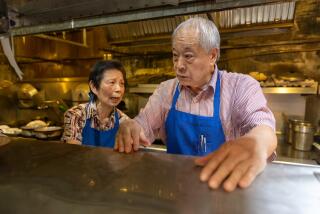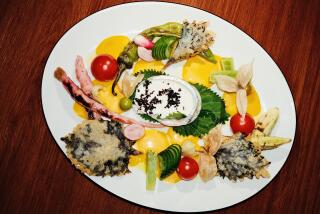Family Joined the Migration That Made Town a City
Hugo Tringali can still remember the directions he got to travel from Los Angeles to the Conejo Valley: Keep driving until you think you must have passed it, then you may be getting close.
When he finally arrived at the village that would become Thousand Oaks, he saw a road sign advertising the town’s population and elevation: both somewhere around 600.
“When we first arrived in the late ‘40s, Thousand Oaks was still a cow town. . . . Kids were riding horses through town, dogs by the dozens were running all over the place. There were no leash laws or curb laws or anything.”
Still, people were coming. Veterans from World War II were looking for a place of their own. And his father, Dominick Tringali, like so many others, wanted a warm, sunny climate and a plot of land he could afford.
“So Dad came to Thousand Oaks and he went into a real estate office there, and the Realtor’s name was Mr. Reynolds. Mr. Reynolds sold my father one acre of property, a full acre, right at the corner of what is now Los Robles Road and Hampshire. . . . This was one full acre for $5,000.”
The land was cheap, with weather similar to that of Dominick Tringali’s home in Italy. Years earlier, Hugo’s father and mother each had emigrated from Sicily with their parents. They later met in New York.
*
After they had made a new life for themselves, and Hugo had graduated from Yonkers High School, World War II broke out. Both father and son joined the Army, leaving his wife and daughters in New York.
Hugo recalled, “While I was working for the government, shouldering a gun in Europe against the German army, Dad was building fortifications in the Caribbean to keep the German submarines from coming into the Panama Canal and so forth. So two of us were working for the U.S. Army in the war effort. This is so true of most immigrants, who were very, very proud, and very, very glad to serve our nation during the war.”
In 1947, after hearing about California from servicemen who had been stationed here, Dominick drove through Simi Valley and Newbury Park before deciding on what is now Thousand Oaks.
His first goal accomplished, making Thousand Oaks his home, the elder Tringali began on his second goal: relocating his wife, Mammie, and daughters from back East. With that in mind, he worked full time at Camarillo State Hospital as a custodian and handyman while building a brick house for his family. He chose brick because he was a stonemason. Dominick was 60 when he began to work on the new house.
“After work, on weekends and on any holidays . . . he would put in all of his time. He would do this all by hand. He would hire help as he needed it. To him it was nothing at all to work until midnight, then go to work on his regular job at the hospital,” Hugo remembered.
“There were two stonemasons in town that were knowledgeable. One was Johnny Beyer and then my dad. Johnny Beyer was known better as a construction, cement block man, whereas my father was the old, original stonemason.
“The stonemason has to pick up every rock, drop his hammer and his trowel, study it, see where it belongs . . . chip it, cut it, or crack it off or cut the corners by hand, piece by piece with sledge hammers, chisels and his other tools.”
*
In 1959, with the house finished, Tringali sent for his wife and daughters. But the work didn’t stop.
“After the house was built and livable, Dad did something even more remarkable: He went down under the house and he started digging out a cellar. So we have a full cellar under that house, hand-dug out of rock and soil. And he carried the dirt out a pailful at a time.”
Hugo would travel from college in Flagstaff, Ariz., to help his father whenever he had time.
“I had taken the Greyhound bus out of Los Angeles heading north somewhere around midnight. I asked the driver, because there weren’t too many passengers on board, to please let me off at the front part of Thousand Oaks, and if I was asleep, to let me know. He said he would.”
Well, Hugo did fall asleep as the bus drove through the winding pre-freeway roads of Sherman Oaks, Encino, Calabasas and finally Thousand Oaks. By the time the bus driver remembered his sleeping passenger, they were at the far end of Thousand Oaks, about three miles from where he needed to be--at 2 in the morning.
On that early morning walk, Hugo passed many small businesses lining Thousand Oaks Boulevard. The first business Hugo passed in the dark was Jockey Mead’s Plunge, a swimming pool and picnic grounds popular with families across the Conejo Valley.
The Redwood Lodge, a two-story western-style building decorated with wagon wheels and frontier-style trappings was next, followed by Henry Notiker’s Rock House, a restaurant and bar. Esse’s Taco Stand, McKnight’s Market and a doughnut shop followed in quick succession. After Rancho Road came Carlson’s Building Materials.
Less than a dozen other businesses stood under the eucalyptus, California pepper and oak trees lining the slender, two-lane road: Lupe’s Mexican Food, Ray Robb’s Hardware, and the Del-Ray Cafe. Then there was Henry Shaw’s Welding and Morrison’s Post Office. And, of course, the wild animal park known as Jungleland.
During Hugo’s trips to Thousand Oaks he helped his father plant an orchard of apricot, plum, citrus, peach and apple trees. They also planted olive trees along the driveway and grapevines against the back wall.
“He had a wine cellar that he’d built down there. He had his wine press and he made his wine by hand with two big wooden barrels.”
While Hugo’s father was tending the orchard and the vineyard, his mother was growing a large garden to keep the family fed. The harvest from the garden and orchard was canned once a year, yielding 300 to 400 quarts that would be stored in the cellar with the wine. In addition to canning jams, jellies and applesauce, Hugo’s mother grew flowers to put in the church every Sunday, raised chickens to sell the eggs, and was one of the few seamstresses in town.
*
Hugo’s parents are now dead. And the brick house is gone, torn down this month to make way for an affordable-housing project. But he has mementos to remind him of their hard work building Thousand Oaks.
“I have Dad’s old work shoes and his old work gloves. Heaven only knows how many thousands of miles those shoes walked around the yard, and how many tons of things those leather gloves picked up. And Mother’s little apron. When she would go out to feed the chickens, there would be so many eggs for her to gather and bring in, she would extend her apron out, put the eggs in the bottom of the apron and walk back into the house.”
(BEGIN TEXT OF INFOBOX / INFOGRAPHIC)
Four years ago, a group of Thousand Oaks residents launched an oral history project to preserve the memories of the Conejo Valley’s early settlers. With support from the Thousand Oaks Library Foundation, dozens of residents were interviewed and their remembrances transcribed and filed at the library. Tina Carlson, who heads the project, has pared down some of the interviews, and provided them to The Times to publish during Conejo Valley Days. Today, using the voice of Hugo Tringali, 72, she tells about the flood of newcomers who arrived in the Conejo Valley after World War II.
More to Read
Sign up for Essential California
The most important California stories and recommendations in your inbox every morning.
You may occasionally receive promotional content from the Los Angeles Times.










